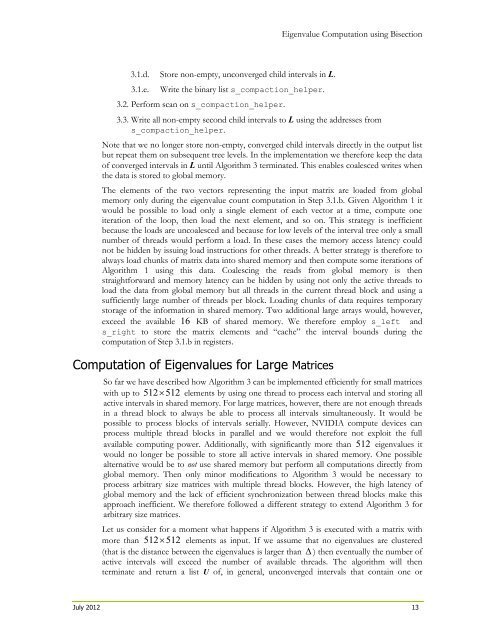Christian Lessig
SORtc
SORtc
- No tags were found...
Create successful ePaper yourself
Turn your PDF publications into a flip-book with our unique Google optimized e-Paper software.
Eigenvalue Computation using Bisection<br />
3.1.d. Store non-empty, unconverged child intervals in L.<br />
3.1.e.<br />
Write the binary list s_compaction_helper.<br />
3.2. Perform scan on s_compaction_helper.<br />
3.3. Write all non-empty second child intervals to L using the addresses from<br />
s_compaction_helper.<br />
Note that we no longer store non-empty, converged child intervals directly in the output list<br />
but repeat them on subsequent tree levels. In the implementation we therefore keep the data<br />
of converged intervals in L until Algorithm 3 terminated. This enables coalesced writes when<br />
the data is stored to global memory.<br />
The elements of the two vectors representing the input matrix are loaded from global<br />
memory only during the eigenvalue count computation in Step 3.1.b. Given Algorithm 1 it<br />
would be possible to load only a single element of each vector at a time, compute one<br />
iteration of the loop, then load the next element, and so on. This strategy is inefficient<br />
because the loads are uncoalesced and because for low levels of the interval tree only a small<br />
number of threads would perform a load. In these cases the memory access latency could<br />
not be hidden by issuing load instructions for other threads. A better strategy is therefore to<br />
always load chunks of matrix data into shared memory and then compute some iterations of<br />
Algorithm 1 using this data. Coalescing the reads from global memory is then<br />
straightforward and memory latency can be hidden by using not only the active threads to<br />
load the data from global memory but all threads in the current thread block and using a<br />
sufficiently large number of threads per block. Loading chunks of data requires temporary<br />
storage of the information in shared memory. Two additional large arrays would, however,<br />
exceed the available 16 KB of shared memory. We therefore employ s_left and<br />
s_right to store the matrix elements and “cache” the interval bounds during the<br />
computation of Step 3.1.b in registers.<br />
Computation of Eigenvalues for Large Matrices<br />
So far we have described how Algorithm 3 can be implemented efficiently for small matrices<br />
with up to 512 512 elements by using one thread to process each interval and storing all<br />
active intervals in shared memory. For large matrices, however, there are not enough threads<br />
in a thread block to always be able to process all intervals simultaneously. It would be<br />
possible to process blocks of intervals serially. However, NVIDIA compute devices can<br />
process multiple thread blocks in parallel and we would therefore not exploit the full<br />
available computing power. Additionally, with significantly more than 512 eigenvalues it<br />
would no longer be possible to store all active intervals in shared memory. One possible<br />
alternative would be to not use shared memory but perform all computations directly from<br />
global memory. Then only minor modifications to Algorithm 3 would be necessary to<br />
process arbitrary size matrices with multiple thread blocks. However, the high latency of<br />
global memory and the lack of efficient synchronization between thread blocks make this<br />
approach inefficient. We therefore followed a different strategy to extend Algorithm 3 for<br />
arbitrary size matrices.<br />
Let us consider for a moment what happens if Algorithm 3 is executed with a matrix with<br />
more than 512 512 elements as input. If we assume that no eigenvalues are clustered<br />
(that is the distance between the eigenvalues is larger than ) then eventually the number of<br />
active intervals will exceed the number of available threads. The algorithm will then<br />
terminate and return a list U of, in general, unconverged intervals that contain one or<br />
July 2012 13


